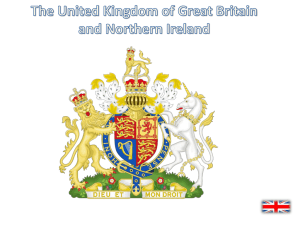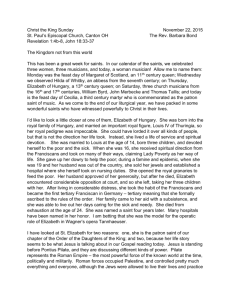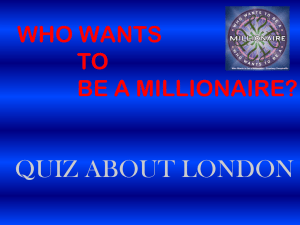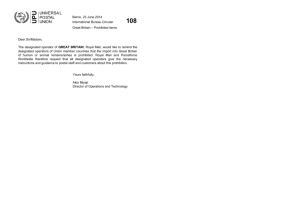Royal coat of arms of the United Kingdom of Great Britain and
advertisement
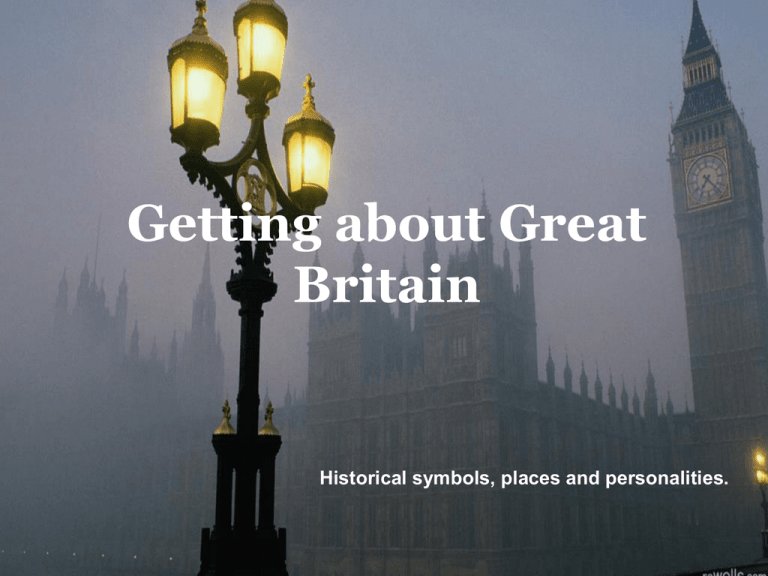
Getting about Great Britain Historical symbols, places and personalities. The Purposes of Presentation • • • • Acquaintance with the geographical position of Great Britain. A short historical review on the peculiarities of government’s development of the United Kingdom of Great Britain. To represent outstanding personalities who are at the head of governing in England at present day. A common view of the most famous places of interest that are historical and modern symbols of England. Great Britain The United Kingdom of Great Britain and Northern Ireland are situated on the British Isles. Their total area is over 244,000 square kilometers. The UK includes four countries: England, Wales, Scotland and Northern Ireland. The capital of the UK is London. Geographical position The term “British Isles” derives from terms used by classical geographers to describe this island group. The earliest known name of Great Britain is Albion . The oldest mention of terms related to the formal name of Britain was made by philisopher Aristotle. The British Isles are separated from European continent by the North Sea and the English Channel. The western coast of GB is washed by the Atlantic Ocean and the Irish Sea. The story of the United Kingdom and the Union Flag • The Union Flag, popularly known as the Union Jack, is the national flag of the United Kingdom. It is the British flag. • It is called the Union Flag because it symbolizes the administrative union of the countries of the United Kingdom. It is made up of the individual Flags of three of the Kingdom's countries all united under one Sovereign - the countries of 'England, 'Scotland' and 'Northern Ireland' (since 1921 only Northern Ireland has been part of the United Kingdom). • As Wales was not a Kingdom but a Principality it could not be included on the flag. EMBLEMS OF BRITAIN Each country in Britain has its own patron saint and floral emblem. England - St. George and the Rose The national flower of England is the rose. The flower has been adopted as England’s emblem since the time of the Wars of the Roses - civil wars (1455-1485) between the royal house of Lancaster (whose emblem was a red rose) and the royal house of York (whose emblem was a white rose). Scotland - St. Andrew and the Thistle and Scottish Bluebell The national flower of Scotland is the thistle, a prickly-leaved purple flower which was first used in the 15th century as a symbol of defence. The Scottish Bluebell is also seen as the flower of Scotland. Wales - St. David and the Daffodil The national flower of Wales is the daffodil, which is traditionally worn on St. David’s Day. The vegetable called leek is also considered to be a traditional emblem of Wales. There are many explanations of how the leek came to be adopted as the national emblem of Wales. One is that St David advised the Welsh, on the eve of battle with the Saxons, to wear leeks in their caps to distinguish friend from foe. Northern Ireland - St. Patrick and the Shamrock The national flower of Northern Ireland is the shamrock, a three-leaved plant similar to clover. An Irish tale tells of how Patrick used the three-leafed shamrock to explain the Trinity. He used it in his sermons to represent how the Father, the Son, and the Holy Spirit could all exist as separate elements of the same entity. His followers adopted the custom of wearing a shamrock on his feast day. Royal coat of arms of the United Kingdom of Great Britain and Northern Ireland. Royal coat of arms of Scotland. The Royal coat of arms of the United Kingdom is the official coat of arms of the British monarch, currently Queen Elizabeth II. These arms are used by the Queen in her official capacity as monarch of the United Kingdom, and are officially known as her Arms of Dominion. Variants of the Royal Arms are used by other members of the Royal Family. The Queen of England Elizabeth II • • • • • • The United Kingdom is a unitary state under a constitutional monarchy. Queen Elizabeth II is the head of state of the UK as well as of fifteen other independent Commonwealth countries. She is Supreme Governor of the Church of England and, in some of her realms, carries the title of Defender of the Faith as part of her full title. Elizabeth was born in London and educated privately at home. She began to undertake public duties during the Second World War . In 1947 she married Prince Philip, Duke of Edinburg, and they have four children: Charles, Anne, Andrew, and Edward. Her coronation service took place in 1953 and was the first to be televised. The Royal Family - Symbols of England Queen Elizabeth II Prince Charles , a son of Elizabeth II Prince William a son of Prince Charles and Princess Diana Bright Episodes of Queen’s Life Historical symbols of England Numerous finds prove that the area around London was inhabited by the Celts. The earliest settlers in the London area lived along parts of the Thames valley. The London area is the most ancient settled part of England’s territory. Over the centuries, London became the centre of the constantly growing Empire. Much of present day London was built in Victoria times, which have brought London power, growth and highly-developed culture and industry. At present days we can visit and see many beautiful historical places of interest that attract tourists. Most of these places became symbols of England. Big Ben Big Ben is the nickname for the great bell of the clock at the north end of the Palace of Westminster in London, officially named the Elizabeth Tower. Elizabeth Tower holds the largest fourfaced chiming clock in the world. It celebrated its 150th anniversary on 31 May 2009. The tower was completed in 1858 and has become one of the most prominent symbols of both London and England. Buckingham palace Buckingham Palace around a central courtyard is the official London residence and principal workplace of the British monarch. It was built for the Duke of Buckingham in 1705. During the 19th century it was enlarged by architects John Nash and Edward Blore. Buckingham Palace finally became the official royal palace of the British monarch on the accession of Queen Victoria in 1837. Trafalgar Square •Trafalgar Square is a public space and tourist attraction in central London, built around the area formerly known as Charing Cross. It is in the borough of the City of Westminster. At its centre is Nelson’s Column, which is guarded by four lion statues at its base. There are a number of statues and sculptures in the square. •The name commemorates the Battle of Trafalgar (1805), a British naval victory of the Napoleonic Wars over France. The original name was to have been “King’s William the Fourth’s Square", but George Ledwell Taylor suggested the name "Trafalgar Square". The City of London It is a busy centre of London with modern buildings, business centres, fashionable hotels. The symbol of economically highlydeveloped country. London Eye • • • • The London Eye, or Millennium Wheel, was officially called the British Airways London Eye and then the Merlin Entertainments London Eye. This is a giant Ferris wheel situated on the banks of the River Thames The entire structure is 135 metres (443 ft) tall and the wheel has a diameter of 120 metres (394 ft). It is the tallest Ferris wheel in Europe, and the most popular paid tourist attraction in the United Kingdom, visited by over 3.5 million people annually. The London Eye adjoins the western end of Jubilee Gardens, on the South Bank of the River Thames between Westminster Bridge and Hungerford Bridge. Links http://www.aboutbritain.com/TrafalgarSquare.htm http://britainisgreat.narod.ru/eng.htm http://en.wikipedia.org/wiki/Parliament_of_Great_Britain http://www.aboutbritain.com/BuckinghamPalace.htm http://en.wikipedia.org/wiki/Big_Ben http://en.wikipedia.org/wiki/London_Eye http://images.yandex.ru/yandsearch?text=great%20britain http://en.wikipedia.org/wiki/Elizabeth_II Thank you for your attention

